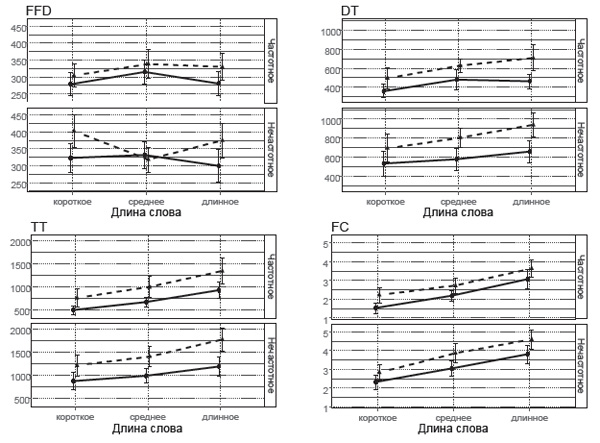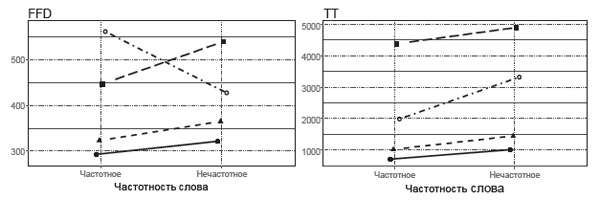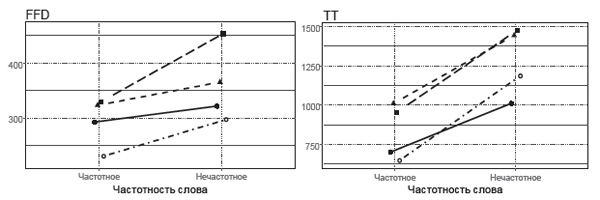Article
Korneev A.A., Akhutina T.V., Matveeva E.Yu. (2019). Reading in third graders with different state of the skill: an eye-tracking study. Moscow University Psychology Bulletin, 2, 64-87
Abstract
Relevance. Eye-tracking study of reading is widely used methodology in modern psychology. But there is a lack of such studies in Russian language. Particularly, there are few eye-tracking studies of reading on early stages of acquisition of this skill.
Objectives. The main aim of our study is to describe process of reading in children 9-10 years old. We compare state of cognitive functions of children and state of their reading skills and try to describe possible strategies for mastering the skill of reading based on indicators of oculomotor activity.
Methods. 56 third graders participated in the study, mean age – 9.62 years old. The reading skills were assessed using the method “Reading regular and irregular words”. We also record eye-movements of the children during reading the corpus of sentences designed for early schoolchildren. Cognitive functions were assessed by neuropsychological assessment adapted for children of 6–9 years old.
Results. We separated the sample into two subgroups with relatively low and high state of reading skill and found differences in the state of cognitive functions and in the oculomotor activity of children in these groups. The children with relatively low reading skill often had weaknesses of executive functions, functions of visual-spatial and auditory information processing. They made more fixations and their fixations were longer than children with high state of the reading skill. A qualitative analysis of the reading of two children with dyslexia and two children with selective development of sub-lexical / lexical routes made it possible to describe the features of reading in children with the weakness of the both strategies or one of them.
Conclusion. The results obtained in the study, on the one hand, show a general interrelation between the features of reading mastering and the state of individual cognitive functions of children, and on the other hand, they indicate that there is no rigid determination of the level of reading development by the state of cognitive functions.
Sections: Empirical studies;
Received: 12/10/2018Accepted: 12/27/2018
Pages: 64-87
DOI: 10.11621/vsp.2019.02.64
Keywords: ">; reading strategies; dyslexia; primary school children; eye tracking; neuropsychology; cognitive functions;
Available Online 30.05.2019

Pic 1.

Pic 2.

Pic 3.
Table 1.
|
Показатель |
Тип слова |
|||
|
Регулярные |
Нерегулярные |
|||
|
Частотные |
Нечастотные |
Частотные |
Нечастотные |
|
|
Продуктивность (из 16) |
14.8 (1.49) |
11.65 (2.64) |
10.35 (5.36) |
6.26 (5.00) |
|
Время чтения (с) |
17.61 (10.17) |
28.15 (13.42) |
20.7 (11.78) |
30.24 (15.6) |
Table 2.
|
Показатель |
Тип слова |
|||||||
|
Частотные регулярные |
Нечастотные регулярные |
Частотные нерегулярные |
Нечастотные нерегулярные |
|||||
|
1 |
2 |
1 |
2 |
1 |
2 |
1 |
2 |
|
|
Продуктивность |
15.78 (0.55) |
14.18 (1.57) |
13.61 (1.54) |
10.39 (2.42) |
14.72 (1.27) |
7.54 (5.09) |
10.94 (2.96) |
3.25 (3.47) |
|
Время чтения (с) |
13.72 (3.82) |
20.11 (12.11) |
20.33 (5.34) |
33.18 (14.66) |
15.94 (4.93) |
23.75 (13.83) |
21.11 (7.24) |
36.11 (16.77) |
Table 3.
|
Инициалы детей |
Число слов, прочтенных за 1 мин. |
Число ошибок |
Баллы по СМИНЧ
|
Оценка чтения |
||
|
по СМИНЧ |
по Русецкой |
|||||
|
Р.А. |
24 |
1 |
3 |
64 |
дислексия |
|
|
Т.А. |
24 |
3 |
9 |
61 |
дислексия |
|
|
В.М. |
68 |
2 |
5 |
86 |
нет дислексии |
|
|
З.М. |
97 |
2 |
6 |
105 |
нет дислексии |
|
Table 4.
|
Показатель |
Тип слов |
Испытуемые |
Среднее по общей выборке |
|||
|
Р.А. |
Т.А. |
В.М. |
З.М. |
|||
|
Продуктивность (из 16) |
Регулярные частотные |
12 |
10 |
15 |
15 |
14.8 |
|
Регулярные нечастотные |
5 |
6 |
10 |
9 |
11.65 |
|
|
Нерегулярные частотные |
0(15.5) |
0(16) |
0(16) |
15 (1) |
10.35 (5.1) |
|
|
Нерегулярные нечастотные |
0 (11) |
0 (16) |
1 (15) |
4 (8) |
6.26 (7.3) |
|
|
Время (с) |
Регулярные частотные |
64 |
47 |
20 |
11 |
17.6 |
|
Регулярные нечастотные |
87 |
53 |
31 |
24 |
28.2 |
|
|
Нерегулярные частотные |
77 |
48 |
19 |
11 |
20.7 |
|
|
Нерегулярные нечастотные |
93 |
50 |
27 |
22 |
30.2 |
|
Table 5.
|
Блоки |
Ученики |
|||
|
Р.А. |
Т.А. |
В.М. |
З.М. |
|
|
Программирования и контроля |
2.69 |
‒0.21 |
1.43 |
0.39 |
|
Обработки слуховой информации |
‒0.55 |
1.33 |
0.75 |
0.71 |
|
Обработки зрительно-пространственной информации |
1.68 |
0.95 |
2.36 |
‒0.74 |
|
Энергетический блок |
0.80 |
1.22 |
2.88 |
‒0.22 |
For citing this article:
Korneev A.A., Akhutina T.V., Matveeva E.Yu. (2019). Reading in third graders with different state of the skill: an eye-tracking study. Moscow University Psychology Bulletin, 2, 64-87








